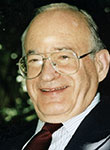Physicist Ernest Sternglass dies at 91
By Blaine Friedlander

Ernest Sternglass ’44, M.S. ’51, Ph.D. ’53, whose correspondence as a young physicist with Albert Einstein led to an electron amplification discovery that – two decades later – allowed hundreds of millions to watch live video of Apollo 11 astronauts walking on the moon, died of heart failure Feb. 12 in Ithaca. He was 91.
Beyond the space program, his physics research led to safer X-ray equipment using digital imaging, which brings out greater detail than is possible with film, using computer image processing. These systems are now used by nearly every doctor and hospital.
As astronaut Neil Armstrong climbed down from the lunar module in July 1969 and walked on the moon, a television camera attached to the moon lander and made by Sternglass’s employer, Westinghouse, captured all the low-light lunar action. Inside the video camera was a highly sensitive TV camera tube, originating from Sternglass’s research. Sternglass had concluded that he had observed a phenomenon that was different from Einstein’s photoelectric effect – for which Einstein won a Nobel Prize in 1921.
As a graduate student, Sternglass wrote to Einstein in November 1950, describing the “secondary electron emission” effect that Sternglass had been researching. Einstein replied that his idea seemed reasonable and urged the young physicist to pursue it.
Einstein counseled Sternglass not to pursue a career in theoretical physics, lest “the originality be crushed out of him.” The Nobelist encouraged him to pursue his own ideas, writing: “Always keep a cobbler’s job where you can get up in the morning and face yourself that you are doing something useful. Nobody can be a genius and solve the problems of the world every day.” Sternglass took Einstein’s advice and pursued advanced degrees at Cornell in applied physics.
The subsequent development of the secondary electron emission theory led to the development of the television camera tube – the so-called image intensifier – that amplified low-light images. The defense department had been using the tube in highly secret spy cameras, but NASA, in the early 1960s, commissioned the company to make similar video cameras for the early moon landings.
In the early 1960s, some scientists and doctors were becoming concerned with the public health effects of atomic bomb testing. Sternglass and others had correlated medical X-ray exposure to the developing fetus with a significantly increased incidence of childhood leukemia and infant mortality. In 1963, on the last day of the Senate Atmospheric Test Ban Treaty hearings, Sternglass testified that atmospheric bomb testing produced the equivalent of several such X-rays. Studies showed that the health impact was far greater than had previously been thought, particularly for unborn children. His testimony helped convince the Senate to adopt the treaty.
After a sabbatical working with Nobel laureate Robert Hofstadter at Stanford in 1967, Sternglass moved to the University of Pittsburgh School of Medicine to organize a new laboratory to develop imaging in medicine – with the hope of developing advanced digital X-ray technology to reduce patients’ radiation exposure and improve image quality, and thereby health outcomes.
Sternglass led pioneering work in digital X-ray imaging at Pittsburgh’s Department of Radiology from 1967 to the early 1990s. In the late 1960s, X-ray images were recorded on film. In 1983, Sternglass and colleagues, including Donald Sashin (radiology, University of Pittsburgh) published “Approaching Radiology's Theoretical Limits,” in the journal Diagnostic Imaging. The physicists had found a way to use conventional X-ray sources with a solid-state detector system to create digital images. The images could be enhanced by a digital computer to expose previously invisible details that were highly valuable to doctors. This work pioneered today’s ubiquitous digital X-ray imaging.
Ernest Joachim Sternglass was born Sept. 24, 1923, in Berlin to Ella and Joseph Sternglass, both physicians. The family fled Nazi Germany in 1938. He graduated from George Washington High School, New York City, in 1940. All from Cornell, Sternglass earned his bachelor’s degree in electrical engineering in 1944, and both his master’s degree (1951) and doctorate (1953) in applied and engineering physics.
Marilyn, his second wife, pre-deceased him in 2004 and his younger brother Arno pre-deceased him in 2007. His marriage to his first wife Lisa ended in divorce.
He is survived by his son Daniel Sternglass ‘80 (Casey Carr ‘74) of Ithaca, by his daughter, Susan Sternglass Noble ‘82, of London, and four grandchildren.
Media Contact
Get Cornell news delivered right to your inbox.
Subscribe